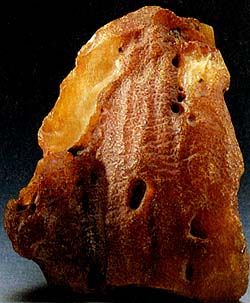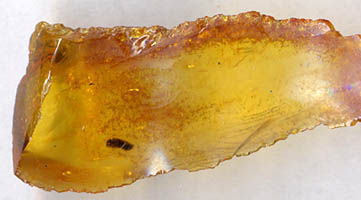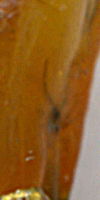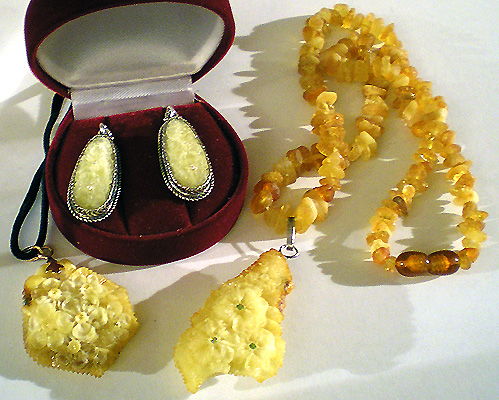Stone, minerals and semiprecious of the world stone
Other: Amber -->rus
 Diagnostic cart.
Diagnostic cart.
Contraction of amber from the Baltic coast
Crystal structure amorphous Hardness on the Mohs scale 1,5-3
Specific unit weight mass 1,05-1,1
Cleavage non-existent
Fracture, break padman
Colors yellow, gold, brown, reddish
Colors in powder triturate white
Glance (glitter, glare) resin
It is petrifying resin of pine-trees of tertiary age, especially Pinus succinifera. Amber is both transparent and opaque. For him characteristic yellow colouring, and also various tints orange, brown-red, green and even blue. Amber has resin brilliance, improved at a polish typically. His commercial value is strongly promoted by inclusion. A yellow or yellowish-brown hard translucent fossil resin derived from extinct coniferous trees that occurs in Tertiary deposits and often contains trapped insects. It is used for jewellery, ornaments, etc.
Diagnostic indication.
Amber is so easy, that floats in the added some the salt water. It is diluted at 350'С, publishing a characteristic smell, conditioned the presence of succinic acid. Under the action of ultraviolet fluorescent white luminescence with a bluish tint. There is other fossil resin, quite different from amber - dug, product of vital functions of bob plant of Hymenaea verrucosa. It is widespread only in Tanzania, Kenya, Mozambique and Madagascar.
Origin provenance genesis.
Amber be found in siltages as concretion and tumours of wrong form and most different sizes. They are covered a light opaque crust.
Deposit minefield mine field occurrence subsoil.
From ancient times famous deposit along the banks of the north Baltic sea, where he is obtained in openworks from mineral deposits, beddings in layers power 6-8 meters. Considerable deposits are located in Russia, Poland and Romania (variety of Rumenite). Shallow deposits are in Burma (Birmite, or Chinese amber), Mexico, Spain, Canada, France and Livane. We will mark the little known Italian amber of simetite, dissipated in a few on stream of the river of Simeto also, in the province of Rolling. In terms of money beds more interesting in mountain part of Santo-domingo (Black friar Republic). Age of these ambers is quite different from Baltic, and considerable sizes have his pieces.
Use, practical application, deployment.
From all of the obtained amber only 15% used as a carpentry stone from which do beads for necklaces, cabochons, valuable engraved wares. Other volume of booty (mostly shallow wreckages) is used in the production of varnishes and pharmaceutics.
Amber is hardening fossil resin of conifers (in Pribaltike mainly pine-trees of Pinus succinifera); appeared mainly in a paleogene 50 million years back. Be found mainly as separate pieces, dropwise excretions or tumours of homogeneous or shell structure, often covered a weathering crust. Quite often in them present inclusion plants or insects. Often is turbid from shallow emptinesses, microcrack and thinnest cracks of tension. By the "clarifying boiling" in colza butter it can ennoble amber, promote his transparency, deleting air bubbles and inclusion liquids. Conduct of amber in relation to chemical reagents and hot changes baths at the stone of different deposits. Amber inflames from a match. At a friction electrified a shawl and begins to attract shallow particles (pieces of paper). Polished well. Has resin brilliance.
Largest in the world succinic deposit - Seashore, it is on Zamlandskom peninsula (Kaliningrad region, CIS). Yantarenosnye fine-grained glauconite, green earth-quartz clay sands, so-called "blue earth", as a layer 9 m bed middle power here under the multimeter layer of sandy deposits. A deposit is developed a quarry. Amber is extracted by hand acquisition classification and washing. Only 15% the obtained amber directly suitable for jeweller aims. Other serves as raw material for the receipt preparation of the pressed amber or sent in foundry, smeltery for processing on technical products (succinic acids, varnish, butter, rosin).
Large supplies of amber are also on the day of the Baltic sea; it is proved by the finds of amber on beachs and in the area of shoal of all of the Baltic states and republics the CIS after severe storms at which waves of surf deeply roil the ground soil. Such "marine amber" differs enhanceable durability and wonderful quality.
Other districts of distribution of amber have an inferior value: Sicily (where he is named by "simetite"), Romania (Rumenite), Burma (Birmite), Canada, some states of the Atlantic coast of the USA, black Friar republic.
Amber from prehistoric times used as material for jeweller decorations, articles of cult, considered that he delivered from illnesses. Amber name "gold of North", it most first jeweller stone, which a people met with. Now amber serves for making of artistically-decorative wares, cannon-bits, smoking tubes, handles of umbrellas etc. objects; it is widely used and on jeweller business: from him do insertions in rings, beads, necklaces.
The shallow pieces of amber and offcuts from his treatment process at 140-250oC and pressures to 3000 atmosphere (285 MPa) in the so-called pressed amber (ambroide) which looks almost as natural. Modern and fossil quaternary resins (dug), synthetic resins, yellow plastics (for example, bakelite) and glasses, serve as imitations of amber.





